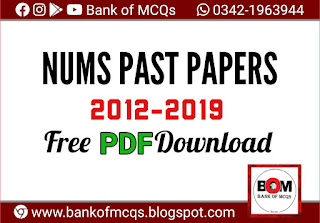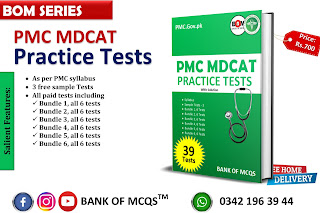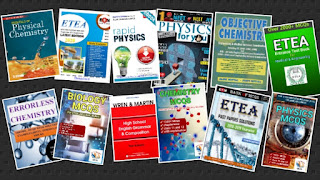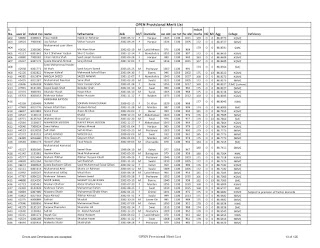chemical reaction chapter mcqs
CHAPTER 6
CHEMICAL REACTIONS
Q.1. All of the following are state
functions except
a. P
b. V
c. q
d. H
(c)
Q. 2. Suppose you have a balloon of
given volume, V1, containing a gas at temperature, T1. When you place the
balloon in a colder room at temperature, T2, the balloon’s temperature starts
to drop. What are the signs of the system’s q, w, and E for this process?
a. +q, +w, + E
b. -q, -w, + E
c. +q, -w, - E
d. –q, +w, - E
(d)
Q. 3. The melting of ice at body
temperature is an endothermic process:
H2O(s) H2O(I) ΔH= +6.0kJ / mol Thus
eating ice counteracts the exothermic processes of metabolizing food. How much
ice (in grams) would you have to eat to counteract the energy gained by eating
28.3g of
peanuts (13 kJ/g)?
a. 78 g
b. 110 g
c. 370 g
d. 1100 g
(d)
Q. 4. All of the following statements
are false except
a. q = H at constant T; q = E at
constant V
b. q = H at constant V; q = E at
constant P
c. q = H at constant P; q = E at
constant V
d. q = H = E at constant P or at
constant V
(c)
Q. 6. Calculate the standards molar
enthalpy of formation of CO2(g) in the reaction:
C(g) +O2(g) CO2(g)
Given the following standard enthalpy
changes:
2C(s) +O2(g) 2CO(g), ΔHo = -221kJ
2CO(g) + O2(g) 2CO2(g), ΔHo = -566kJ
a. -393.5 kJ
b. +393.5 kJ
c. +787.0 kJ
d. -787.0 kJ
(a)
Q. 7. All of the following chemical
reactions are endothermic except
a. H2O(s) H2O(I)
b. 2H2O(g) 2H2(g) +O2(g)
c. H2O(g) H2O(I)
d. AI2O3(I) + 2Fe(I) 2AI(s) + Fe2O3(s)
(c)
Q. 8. All of the followings are
incorrect except
a. Hvaprizaiton < Hsublimation <
Hfusion < Hcondensation
b. Hfusion < Hcondensation <
sublimation < Hvaporization
c. Hcondensation < Hfusion <
Hvaporization < Hsublimation
d. Hcondensation < Hsublimation
< Hfusion < Hvaporization
(c)
Q. 10. A chemist heated a balloon by
supplying 600 J of heat. The balloon expands doing 200 J of
work against the atmospheric pressure.
The change in internal energy of
a. -800 J
b. -400 J
c. O J
d. +400 J
(d)
Q. 11. Spontaneous reactions are those
which
a. continue to occur once started
b. require activation energy
c. are endothermic
d. are exothermic
(a)
Q. 12. All of the following processes
are spontaneous except
a. reaction of H2 with O2 to form H2O
b. combustion of natural gas
c. neutralization of HCI by NaOH
d. synthesis of glucose by plants
(d)
Q. 14. The following table provide
different types of system and their examples but in irregular manner. System
Example
I. Open a. water in cork fitted
titration flask
II. Closed b. pigeon
III. isolated c. ice in thermos bottle
Which of the following is a best match
of both columns?
a. (I, a), (II, b), (III, c)
b. (I, b), (II, a), (III, c)
c. (I, c), (II, a), (III, b)
d. (I, b), (II, c), (III, a)
(b)
Q. 15. Sublimation, vaporization,
melting and photosynthesis all are examples of
a. chemical processes
b. physical processes
c. biochemical processes
d. endothermic processes
(d)
Q. 16. A mixture of ice and water
contains 60g of ice and 60g of water. If 60J of heat energy is removed
from this mixture then some of the
a. water will vaporize
b. ice will sublime
c. ice will melt
d. water will freeze
(d)
Q. 17. Pieces of four different metals
are present on a table. These metals are Na, AI, W and Ti. Their
melting points are 98, 660, 3410 and
1660 oC respectively. Metal having maximum enthalpy of
fusion is
a. Ti
b. AI
c. W
d. Na
(c)
Q. 18. If volume of a system is kept
constant and heat is supplied to the system then
a. internal energy of the system
increases and no work is done on the surrounding
b. internal energy of the system
increases and work is done on the surrounding
c. no change in internal energy occurs
d. no work is done on the surrounding
(a)
Q. 19. Melting of ice at room
temperature is
a. spontaneous exothermic process
b. spontaneous endothermic process
c. non-spontaneous exothermic process
d. non-spontaneous endothermic process
(b)
CHAPTER 7
CHEMICAL EQUILIBRIUM
Q. 1. At 1000 C, the equilibrium
constant for the reaction of carbon monoxide and oxygen to produce
carbon dioxide is very large (Kc = 1.2
x 1022). When the reaction is at equilibrium the:
a. concentration of carbon dioxide
will be much larger than one or both reactants
b. concentration of carbon dioxide
will be much smaller than concentrations of both reactants
c. concentration of carbon monoxide
will be much larger than the concentration of carbon dioxide
d. concentrations of both reactants
must be much smaller than the concentration of carbon dioxide
(a)
Q. 2. A cylinder contains a unknown
gas “X”. When the cylinder is heated a reddish brown color
develops. It means that the gas
present in the cylinder was
a. NO2
b. N2O
c. N2O5
d. N2O4
(d)
Q. 3. A beaker contains a saturated
solution of potassium Perchlorate. When potassium chloride (KCI) is added to
this solution, some of the potassium Perchlorate is precipitated. It means that
a. KCIO4 is strong electrolyte that
KCI
b. Solubility of KCIO4 is greater than
that of KCI
c. Both KCIO4 and KCI are soluble in
water to some extent
d. KCI is a strong electrolyte as
compared with KCIO4
(d)
Q. 4. In salt analysis 3rd group basic
radicals (Al3+, Fe3+ etc) are detected by adding NH4CI to the salt solution and
then NH4OH. 3rd group radicals are precipitated as hydroxide. In this process
a. NH4CI will ionize to a lesser
extent in presence of NH4CI
b. NH4CI will precipitate
c. NH4CI will react with NH4CI
d. AL3+ will precipitate as AICI3
(a)








Comments
Post a Comment